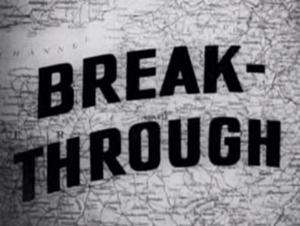Break-through (1944 film) facts for kids
Quick facts for kids Break-through |
|
|---|---|

Screenshot of the opening title
|
|
| Produced by | James Beveridge |
| Narrated by | Lorne Greene |
| Studio | National Film Board of Canada |
| Distributed by | Columbia Pictures of Canada |
| Release date(s) | 1944 |
| Running time | 11 minutes |
| Country | Canada |
| Language | English |
Break-through is a short Canadian documentary film from 1944. It was made during World War II by the National Film Board of Canada (NFB). This film tells the exciting story of the Allied forces attacking Fortress Europe and pushing towards Nazi Germany. It was part of a series called Canada Carries On. James Beveridge produced the film. Its French title is L'assaut.
The D-Day Invasion and Allied Advance
On June 6, 1944, a huge fleet of ships and planes supported Allied troops as they launched a massive invasion of Normandy, France. This day is famously known as D-Day. The First Canadian Army, led by General Harry Crerar, was a key part of this attack.
Securing the Beachhead
The Allied armies faced very strong resistance from Nazi forces. Despite this, they managed to create a secure area, called a beachhead, on the Normandy coast. The Canadians, who had faced a tough battle at Dieppe raid in 1942, fought bravely at Juno Beach and successfully took control of it. After securing the beach, more supplies and soldiers arrived to help the Allied troops get ready to move further into France. The Canadian soldiers were given the important task of attacking Caen, a city in France held by the German 7th Army.
Pushing Through France
In the Normandy countryside, Allied planes, including fighter-bombers, bombed enemy defenses very precisely. Fleets of Supermarine Spitfires and Hawker Typhoons also cleared the skies. The Canadian air and ground forces worked together very closely. This teamwork helped the First Canadian Army steadily advance towards Caen.
By the end of June, there was intense street fighting in Caen. After this, the Canadians continued to push the Nazi defenders back through the hedgerows outside the city. When Canadian troops finally freed Caen, they found a city that had been badly damaged. However, the French citizens who remained were very happy to see them. At the same time, other Allied attacks across France led to the freedom of cities like Marseilles, Toulon, Bourdeaux, and even Paris.
Trapping the Enemy
The Canadians joined other Allied forces to surround the remaining enemy soldiers in an area known as the Falaise Pocket. This led to the collapse of the German defense lines. The trapped Nazi 7th Army was captured. As the Canadian troops kept moving eastward towards the borders of Nazi Germany, it became clear how different Canada's "citizen army" was from the desperate Nazi soldiers who were forced to fight.
Who Was in the Film?
This film includes real footage of important military leaders and journalists from the time.
- General Harry Crerar as Himself (archival footage)
- Correspondent Ross Munro as Himself (archival footage)
- General Bernard Montgomery as Himself (archival footage)
- General Dwight D. Eisenhower as Himself (archival footage)
- Marshal of the Royal Air Force Arthur Tedder as Himself (archival footage)
How the Film Was Made
Break-through was a typical NFB documentary from World War II. It was made to boost morale and encourage people to support the war effort. The film was a compilation documentary. This means it was put together using lots of real combat footage. This footage was shot by Canadian, U.S. Army, and British Army film units. Producer James Beveridge then edited it to tell a clear story.
The film's narration featured the deep voice of stage actor Lorne Greene. Greene was well-known for his radio work as a news announcer for the CBC. He also narrated many films in the Canada Carries On series. His powerful voice earned him nicknames like "The Voice of Canada" and even "voice-of-God." When he read serious news or grim battle statistics, he was sometimes called "The Voice of Doom."
See also
- Road to the Reich (1945)
- The War Is Over (1945)

